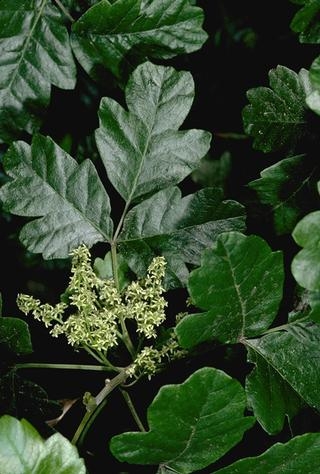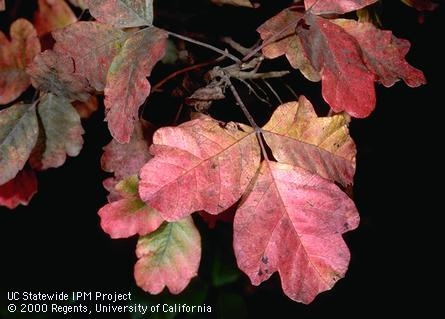Help for the Home Gardener from the Help Desk of the
UC Master Gardener Program of Contra Costa County

Help Desk Response: Thank you for contacting the UC Master Gardener Program Help Desk with your question about managing poison oak (Toxicodendron diversilobum) on your back yard hillside that has yet to be landscaped. Poison oak thrives in uncultivated areas so it is not surprising that you would have a healthy population of it on your hillside.
Poison oak eradication and control can be a formidable task, especially for a home gardener.
University of California guidance is: “The primary ways of managing poison oak are mechanical removal by hand pulling, which is not recommended for individuals who are sensitive to this plant, and treatment with herbicides. Maintaining a healthy cover of desirable vegetation will reduce potential invasion. This is easiest where you have available irrigation and regularly cultivated soil.”
You mentioned that herbicide had been applied several years ago but that the poison oak has grown back. Unfortunately, one application of herbicide is not expected to control poison oak. It will resprout, and the new growth should be treated again. The timing of herbicide treatment is also important for effectiveness, and different herbicides have different optimal application timing related to the plant growth stage.
Spraying the leaves with herbicide is most effective after leaves are fully developed and when the plant is actively growing. This period is normally from April into June or July, when soil moisture is still adequate.

Glyphosate is one of the most effective herbicides for controlling poison oak. However, effective control depends upon the proper timing of the application. Apply glyphosate late in the growth cycle, after the fruit has formed but before leaves have lost their green color. Be sure to check the product label before you buy: you should apply glyphosate as a 2% solution in water. Products or spray mixtures containing less than 2% glyphosate may not effectively control poison oak.
Auxinic herbicides such as triclopyr, 2,4-D, dicamba, and combinations of these herbicides also control poison oak. You can apply these herbicides earlier than glyphosate when plants are growing rapidly from spring to midsummer.
If you want to begin controlling the poison oak right away, we recommend that you use triclopyr, 2,4-D, dicamba, or combinations of these herbicides, as described above. If you want to wait until later, or if you treat now and then there is resprouting later in the season, a 2% solution of glyphosate would be your best choice.
Be sure to follow all label directions when using a herbicide, and take precautions to avoid endangering yourself, other persons, pets, wildlife, and sensitive plants that you do not wish to kill. A discussion of precautions can be found at this University of California website: http://ipm.ucanr.edu/PMG/PESTNOTES/warning.html.
Additional information about poison oak can also be found here http://ipm.ucanr.edu/PMG/PESTNOTES/pn7431.html.
I hope that this information is helpful.
Help Desk of the UC Master Gardener Program of Contra Costa County (JL)
Note: The UC Master Gardeners Program of Contra Costa's Help Desk is available year-round to answer your gardening questions. Except for a few holidays, we're open every week, Monday through Thursday for walk-ins from 9:00 am to Noon at 75 Santa Barbara Road, 2d Floor, Pleasant Hill, CA 94523. We can also be reached via telephone: (925) 646-6586, email: ccmg@ucanr.edu, or on the web at http://ccmg.ucanr.edu/Ask_Us/ MGCC Blogs can be found at http://ccmg.ucanr.edu/HortCoCo/ You can also subscribe to the Blog (http://ucanr.edu/blogs/CCMGBlog/).
Advice for the Home Gardener from the Help Desk of the
UC Master Gardener Program of Contra Costa County
Client's Request: I've heard that I can use yellow corn meal to control weeds. Is this doable and will it hurt the soil?
Help Desk Response: Thank you for contacting the UC Master Gardener Program Help Desk with your question about cornmeal and weeds. I am going to assume that you mean corn meal gluten (CGM), a by-product of corn starch manufacturing that is marketed to home gardeners for pre-emergent control of weeds, especially in lawns. Yellow corn meal makes great polenta, but won't do much for weeds!
University of California research has not shown CGM to be an effective weed control strategy, but in a lawn, it may work because it is high in nitrogen and will feed the lawn, making it more dense, and likely crowding out weeds. Lawns already fed with high nitrogen fertilizers probably won't show any significant benefit from CGM.
CGM will have no effect on already-emerged weeds; it only suppresses some seeds' ability to sprout. It is sometimes used though where only organic herbicides are permitted, but its effectiveness is still questionable. It should not have adverse effects on soil. Because it is high in nitrogen, it could be beneficial if your soil is deficient in that nutrient.
Better weed control can be achieved by heavily mulching the area, which will prevent weed seeds from sprouting. At this time of the year, late winter, when many of our weeds have already come up, you can try hand-pulling or hoeing out the small weeds. They are always easiest to control when they are small. This link will give you great information from UC about weed management in the landscape: http://ipm.ucanr.edu/PMG/PESTNOTES/pn7441.html. The key to successfully reducing the weed problem in future years is to make sure none of this year's weeds go to seed.
Weeds in our gardens are frustrating and seem to be extra-abundant this year because of all the rain we've had. Good luck!
Help Desk of the UC Master Gardener Program of Contra Costa County (SEH)
Don't miss our 2017 Great Tomato Plant Sale:
http://ccmg.ucanr.edu/EdibleGardening/GreatTomatoPlantSale/
Note: The UC Master Gardeners Program of Contra Costa's Help Desk is available year-round to answer your gardening questions. Except for a few holidays, we're open every week, Monday through Thursday for walk-ins from 9:00 am to Noon at 75 Santa Barbara Road, 2d Floor, Pleasant Hill, CA 94523. We can also be reached via telephone: (925) 646-6586, email: ccmg@ucanr.edu, or on the web at http://ccmg.ucanr.edu/Ask_Us/ MGCC Blogs can be found at http://ccmg.ucanr.edu/HortCoCo/ You can also subscribe to the Blog (http://ucanr.edu/blogs/CCMGBlog/).

